window BUICK RANDEZVOUS 2007 Owner's Guide
[x] Cancel search | Manufacturer: BUICK, Model Year: 2007, Model line: RANDEZVOUS, Model: BUICK RANDEZVOUS 2007Pages: 528, PDF Size: 2.99 MB
Page 203 of 528

Rear Window Defogger
The rear window defogger uses a warming grid to
remove fog from the rear window.
button will come on to let you know that the
rear window defogger is activated.
The rear window defogger will turn off
approximately 10 minutes after the button is
pressed. If turned on again, the defogger will only
run for approximately �ve minutes before
turning off. The defogger can also be turned off by
pressing the button again or by turning off the
engine.
Notice:Do not use anything sharp on the
inside of the rear window. If you do, you could
cut or damage the warming grid, and the
repairs would not be covered by your warranty.
Do not attach a temporary vehicle license,
tape, a decal or anything similar to the
defogger grid.
Dual Climate Control System
Your vehicle may have a dual climate control
system. With this system you can control
the heating, cooling, and ventilation for your
vehicle.
Operation
Turn the right knob clockwise or counterclockwise
to direct the air�ow inside your vehicle.
203
Page 205 of 528
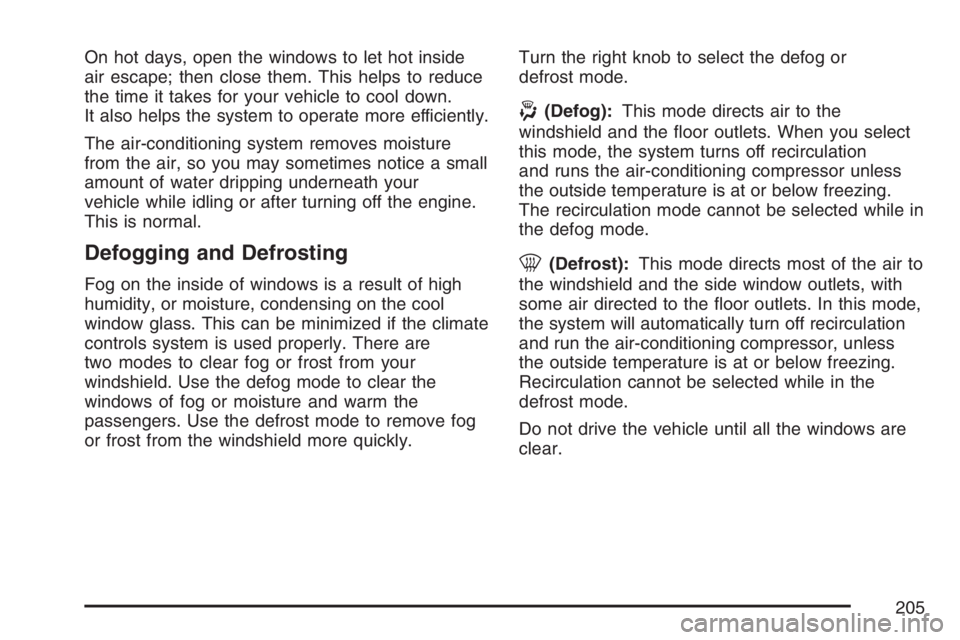
On hot days, open the windows to let hot inside
air escape; then close them. This helps to reduce
the time it takes for your vehicle to cool down.
It also helps the system to operate more efficiently.
The air-conditioning system removes moisture
from the air, so you may sometimes notice a small
amount of water dripping underneath your
vehicle while idling or after turning off the engine.
This is normal.
Defogging and Defrosting
Fog on the inside of windows is a result of high
humidity, or moisture, condensing on the cool
window glass. This can be minimized if the climate
controls system is used properly. There are
two modes to clear fog or frost from your
windshield. Use the defog mode to clear the
windows of fog or moisture and warm the
passengers. Use the defrost mode to remove fog
or frost from the windshield more quickly.Turn the right knob to select the defog or
defrost mode.
-(Defog):This mode directs air to the
windshield and the �oor outlets. When you select
this mode, the system turns off recirculation
and runs the air-conditioning compressor unless
the outside temperature is at or below freezing.
The recirculation mode cannot be selected while in
the defog mode.
0(Defrost):This mode directs most of the air to
the windshield and the side window outlets, with
some air directed to the �oor outlets. In this mode,
the system will automatically turn off recirculation
and run the air-conditioning compressor, unless
the outside temperature is at or below freezing.
Recirculation cannot be selected while in the
defrost mode.
Do not drive the vehicle until all the windows are
clear.
205
Page 206 of 528
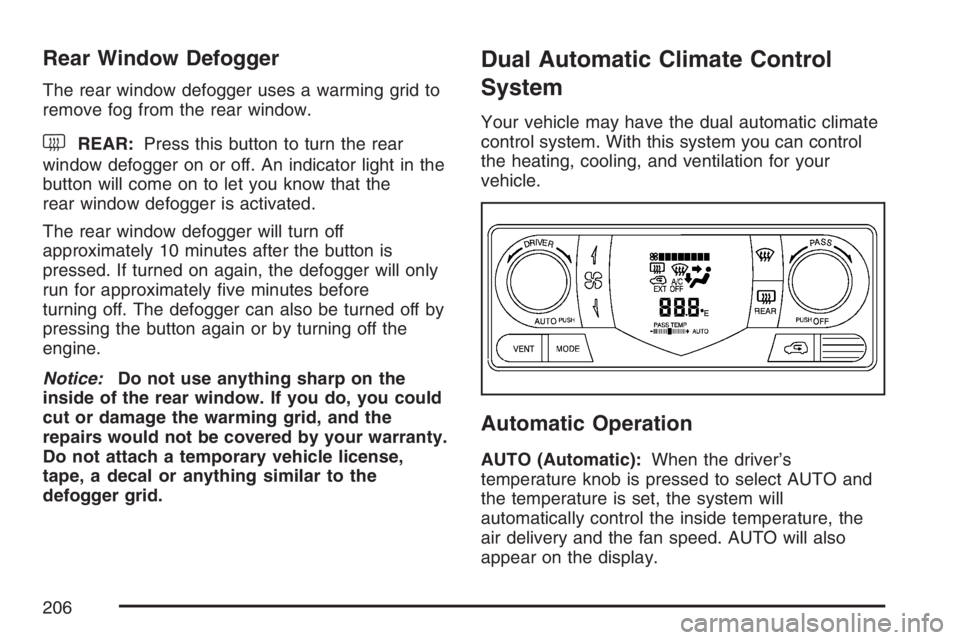
Rear Window Defogger
The rear window defogger uses a warming grid to
remove fog from the rear window.
button will come on to let you know that the
rear window defogger is activated.
The rear window defogger will turn off
approximately 10 minutes after the button is
pressed. If turned on again, the defogger will only
run for approximately �ve minutes before
turning off. The defogger can also be turned off by
pressing the button again or by turning off the
engine.
Notice:Do not use anything sharp on the
inside of the rear window. If you do, you could
cut or damage the warming grid, and the
repairs would not be covered by your warranty.
Do not attach a temporary vehicle license,
tape, a decal or anything similar to the
defogger grid.
Dual Automatic Climate Control
System
Your vehicle may have the dual automatic climate
control system. With this system you can control
the heating, cooling, and ventilation for your
vehicle.
Automatic Operation
AUTO (Automatic):When the driver’s
temperature knob is pressed to select AUTO and
the temperature is set, the system will
automatically control the inside temperature, the
air delivery and the fan speed. AUTO will also
appear on the display.
206
Page 208 of 528
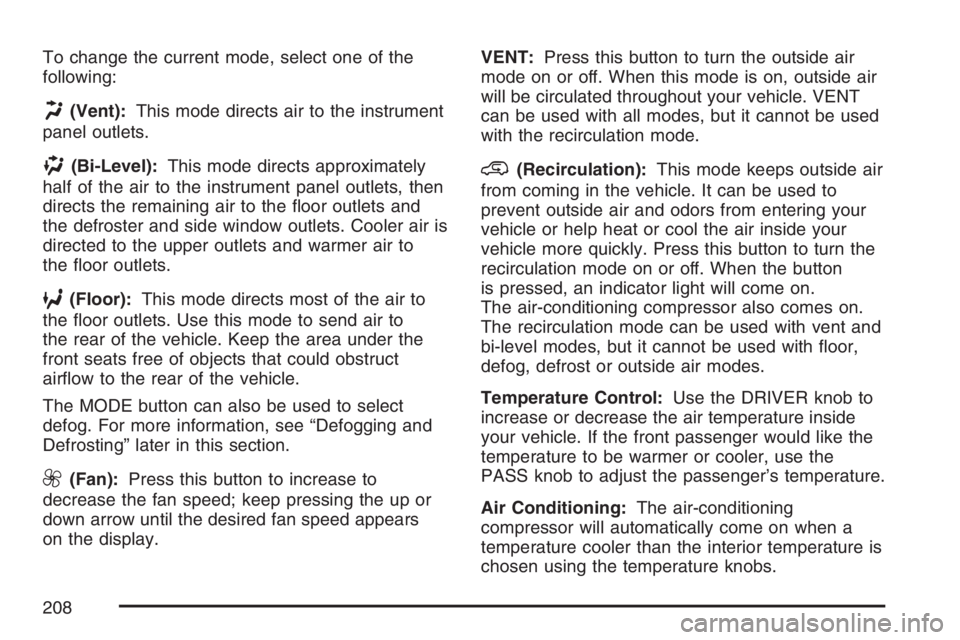
To change the current mode, select one of the
following:
H(Vent):This mode directs air to the instrument
panel outlets.
)(Bi-Level):This mode directs approximately
half of the air to the instrument panel outlets, then
directs the remaining air to the �oor outlets and
the defroster and side window outlets. Cooler air is
directed to the upper outlets and warmer air to
the �oor outlets.
6(Floor):This mode directs most of the air to
the �oor outlets. Use this mode to send air to
the rear of the vehicle. Keep the area under the
front seats free of objects that could obstruct
air�ow to the rear of the vehicle.
The MODE button can also be used to select
defog. For more information, see “Defogging and
Defrosting” later in this section.
9(Fan):Press this button to increase to
decrease the fan speed; keep pressing the up or
down arrow until the desired fan speed appears
on the display.VENT:Press this button to turn the outside air
mode on or off. When this mode is on, outside air
will be circulated throughout your vehicle. VENT
can be used with all modes, but it cannot be used
with the recirculation mode.
@(Recirculation):This mode keeps outside air
from coming in the vehicle. It can be used to
prevent outside air and odors from entering your
vehicle or help heat or cool the air inside your
vehicle more quickly. Press this button to turn the
recirculation mode on or off. When the button
is pressed, an indicator light will come on.
The air-conditioning compressor also comes on.
The recirculation mode can be used with vent and
bi-level modes, but it cannot be used with �oor,
defog, defrost or outside air modes.
Temperature Control:Use the DRIVER knob to
increase or decrease the air temperature inside
your vehicle. If the front passenger would like the
temperature to be warmer or cooler, use the
PASS knob to adjust the passenger’s temperature.
Air Conditioning:The air-conditioning
compressor will automatically come on when a
temperature cooler than the interior temperature is
chosen using the temperature knobs.
208
Page 209 of 528
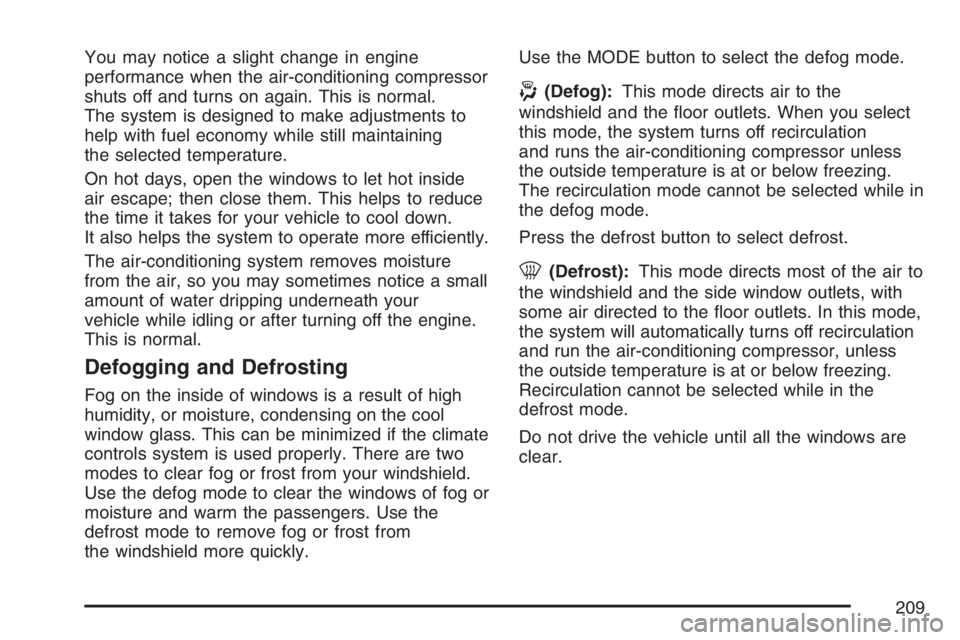
You may notice a slight change in engine
performance when the air-conditioning compressor
shuts off and turns on again. This is normal.
The system is designed to make adjustments to
help with fuel economy while still maintaining
the selected temperature.
On hot days, open the windows to let hot inside
air escape; then close them. This helps to reduce
the time it takes for your vehicle to cool down.
It also helps the system to operate more efficiently.
The air-conditioning system removes moisture
from the air, so you may sometimes notice a small
amount of water dripping underneath your
vehicle while idling or after turning off the engine.
This is normal.
Defogging and Defrosting
Fog on the inside of windows is a result of high
humidity, or moisture, condensing on the cool
window glass. This can be minimized if the climate
controls system is used properly. There are two
modes to clear fog or frost from your windshield.
Use the defog mode to clear the windows of fog or
moisture and warm the passengers. Use the
defrost mode to remove fog or frost from
the windshield more quickly.Use the MODE button to select the defog mode.
-(Defog):This mode directs air to the
windshield and the �oor outlets. When you select
this mode, the system turns off recirculation
and runs the air-conditioning compressor unless
the outside temperature is at or below freezing.
The recirculation mode cannot be selected while in
the defog mode.
Press the defrost button to select defrost.
0(Defrost):This mode directs most of the air to
the windshield and the side window outlets, with
some air directed to the �oor outlets. In this mode,
the system will automatically turns off recirculation
and run the air-conditioning compressor, unless
the outside temperature is at or below freezing.
Recirculation cannot be selected while in the
defrost mode.
Do not drive the vehicle until all the windows are
clear.
209
Page 210 of 528

Rear Window Defogger
The rear window defogger uses a warming grid to
remove fog from the rear window.
button will come on to let you know that the
rear window defogger is activated.
The rear window defogger will turn off
approximately 10 minutes after the button is
pressed. If turned on again, the defogger will only
run for approximately �ve minutes before
turning off. The defogger can also be turned off by
pressing the button again or by turning off the
engine.
If your vehicle has heated outside rearview
mirrors, the mirrors will heat to help clear fog or
frost from the surface of the mirror when the
rear window defog button is pressed.
Notice:Do not use anything sharp on the
inside of the rear window. If you do, you could
cut or damage the warming grid, and the repairs
would not be covered by your warranty. Do not
attach a temporary vehicle license, tape, a decal
or anything similar to the defogger grid.
Outlet Adjustment
Use the louvers located on the air outlets to
change the direction of the air�ow.
Operation Tips
Clear away any ice, snow, or leaves from the
air inlets at the base of the vehicle that may
block the �ow of air into your vehicle.
Do not use any non-GM approved hood
de�ectors that could adversely affect the
performance of the system.
Keep the path under the front seats clear of
objects to help circulate the air inside of
your vehicle more effectively.
210
Page 285 of 528
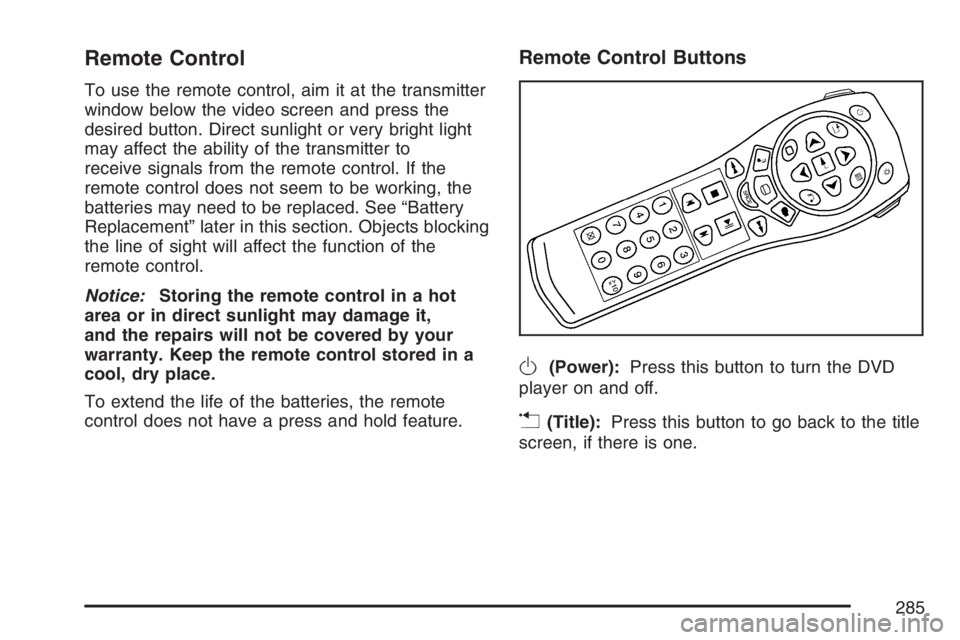
Remote Control
To use the remote control, aim it at the transmitter
window below the video screen and press the
desired button. Direct sunlight or very bright light
may affect the ability of the transmitter to
receive signals from the remote control. If the
remote control does not seem to be working, the
batteries may need to be replaced. See “Battery
Replacement” later in this section. Objects blocking
the line of sight will affect the function of the
remote control.
Notice:Storing the remote control in a hot
area or in direct sunlight may damage it,
and the repairs will not be covered by your
warranty. Keep the remote control stored in a
cool, dry place.
To extend the life of the batteries, the remote
control does not have a press and hold feature.
Remote Control Buttons
O(Power):Press this button to turn the DVD
player on and off.
v(Title):Press this button to go back to the title
screen, if there is one.
285
Page 290 of 528
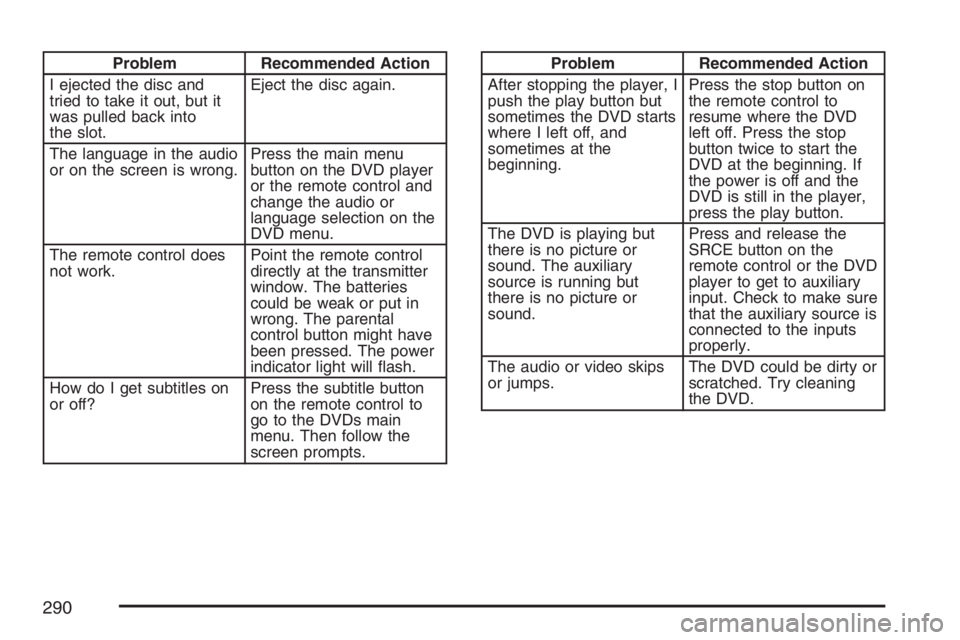
Problem Recommended Action
I ejected the disc and
tried to take it out, but it
was pulled back into
the slot.Eject the disc again.
The language in the audio
or on the screen is wrong.Press the main menu
button on the DVD player
or the remote control and
change the audio or
language selection on the
DVD menu.
The remote control does
not work.Point the remote control
directly at the transmitter
window. The batteries
could be weak or put in
wrong. The parental
control button might have
been pressed. The power
indicator light will �ash.
How do I get subtitles on
or off?Press the subtitle button
on the remote control to
go to the DVDs main
menu. Then follow the
screen prompts.Problem Recommended Action
After stopping the player, I
push the play button but
sometimes the DVD starts
where I left off, and
sometimes at the
beginning.Press the stop button on
the remote control to
resume where the DVD
left off. Press the stop
button twice to start the
DVD at the beginning. If
the power is off and the
DVD is still in the player,
press the play button.
The DVD is playing but
there is no picture or
sound. The auxiliary
source is running but
there is no picture or
sound.Press and release the
SRCE button on the
remote control or the DVD
player to get to auxiliary
input. Check to make sure
that the auxiliary source is
connected to the inputs
properly.
The audio or video skips
or jumps.The DVD could be dirty or
scratched. Try cleaning
the DVD.
290
Page 323 of 528
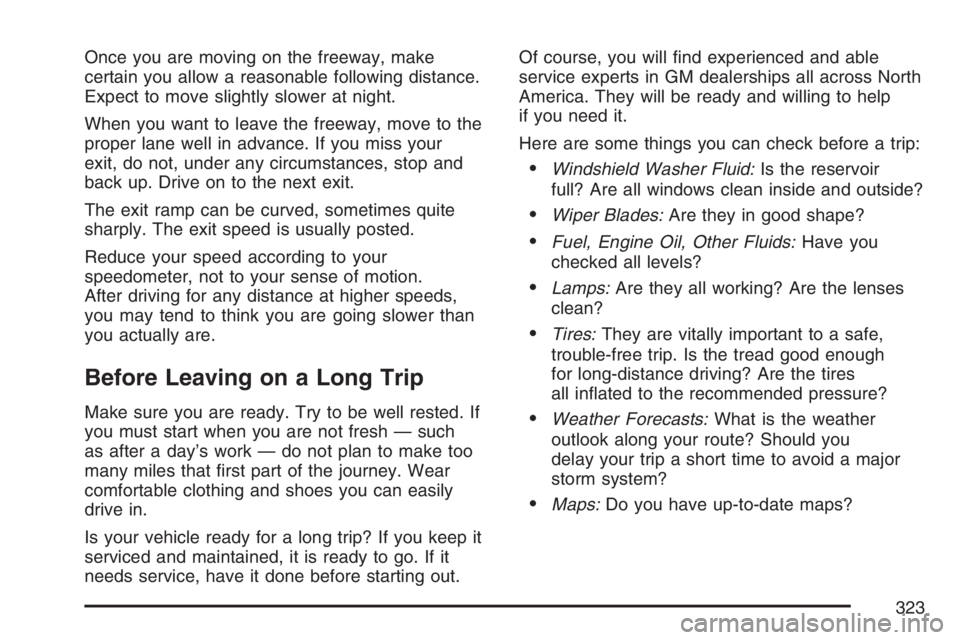
Once you are moving on the freeway, make
certain you allow a reasonable following distance.
Expect to move slightly slower at night.
When you want to leave the freeway, move to the
proper lane well in advance. If you miss your
exit, do not, under any circumstances, stop and
back up. Drive on to the next exit.
The exit ramp can be curved, sometimes quite
sharply. The exit speed is usually posted.
Reduce your speed according to your
speedometer, not to your sense of motion.
After driving for any distance at higher speeds,
you may tend to think you are going slower than
you actually are.
Before Leaving on a Long Trip
Make sure you are ready. Try to be well rested. If
you must start when you are not fresh — such
as after a day’s work — do not plan to make too
many miles that �rst part of the journey. Wear
comfortable clothing and shoes you can easily
drive in.
Is your vehicle ready for a long trip? If you keep it
serviced and maintained, it is ready to go. If it
needs service, have it done before starting out.Of course, you will �nd experienced and able
service experts in GM dealerships all across North
America. They will be ready and willing to help
if you need it.
Here are some things you can check before a trip:
Windshield Washer Fluid:Is the reservoir
full? Are all windows clean inside and outside?
Wiper Blades:Are they in good shape?
Fuel, Engine Oil, Other Fluids:Have you
checked all levels?
Lamps:Are they all working? Are the lenses
clean?
Tires:They are vitally important to a safe,
trouble-free trip. Is the tread good enough
for long-distance driving? Are the tires
all in�ated to the recommended pressure?
Weather Forecasts:What is the weather
outlook along your route? Should you
delay your trip a short time to avoid a major
storm system?
Maps:Do you have up-to-date maps?
323
Page 330 of 528

You can run the engine to keep warm, but be
careful.
{CAUTION:
Snow can trap exhaust gases under your
vehicle. This can cause deadly CO
(carbon monoxide) gas to get inside. CO
could overcome you and kill you. You
cannot see it or smell it, so you might not
know it is in your vehicle. Clear away
snow from around the base of your
vehicle, especially any that is blocking
your exhaust pipe. And check around
again from time to time to be sure snow
does not collect there.
Open a window just a little on the side of
the vehicle that is away from the wind.
This will help keep CO out.
Run your engine only as long as you must. This
saves fuel. When you run the engine, make it go a
little faster than just idle. That is, push the
accelerator slightly. This uses less fuel for the
heat that you get and it keeps the battery charged.
330